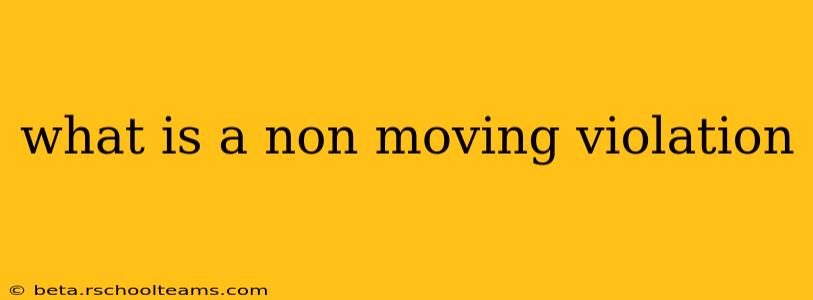A non-moving violation, also known as a parking violation or stationary violation, is a traffic offense that occurs when a vehicle is parked or stationary. Unlike moving violations, which involve a vehicle in motion, non-moving violations don't require the vehicle to be actively driven at the time of the infraction. These violations typically don't involve accidents or endangerment of other drivers. They primarily focus on the improper placement or condition of a parked vehicle.
What are some examples of non-moving violations?
Many common traffic infractions fall under the category of non-moving violations. Here are a few examples:
- Expired registration: Driving with a license plate that has an expired registration sticker is a common non-moving violation.
- Expired inspection sticker: Similar to expired registration, an expired vehicle inspection sticker indicates the vehicle hasn't undergone the required safety checks.
- Parking violations: These include parking in a no-parking zone, exceeding the time limit in a metered spot, blocking a driveway or fire hydrant, parking too close to an intersection, or violating handicapped parking regulations.
- Equipment violations: Defective equipment such as broken headlights, taillights, or turn signals can be considered non-moving violations, even if the car is parked.
- Window tint violation: Having excessively dark window tinting that doesn't meet legal requirements is another example.
- Failure to display proper plates: This includes missing license plates or having license plates that are illegible or improperly displayed.
How are non-moving violations different from moving violations?
The key difference lies in the vehicle's state at the time of the infraction. Moving violations involve the vehicle being in motion, such as speeding, reckless driving, running a red light, or tailgating. These often carry more severe penalties than non-moving violations. Moving violations frequently lead to points added to your driving record, higher insurance premiums, and potential license suspension. Non-moving violations usually result in fines, but generally don't affect your driving record as severely.
What are the penalties for non-moving violations?
Penalties for non-moving violations vary depending on the specific violation and the jurisdiction. Common penalties include:
- Fines: These are the most common penalty for non-moving violations, and the amount can range significantly based on the severity of the infraction.
- Towing: In cases such as parking illegally in a tow-away zone, your vehicle may be towed, and you'll face additional fees for towing and storage.
- Boot: In some areas, a "wheel boot" might be placed on your vehicle, preventing you from driving until the fine is paid.
Can non-moving violations affect insurance rates?
While generally not as impactful as moving violations, some non-moving violations can affect your insurance rates. Insurance companies consider your driving history when determining premiums, and a pattern of non-moving violations, particularly multiple parking tickets, might suggest a disregard for traffic laws, leading to a rate increase.
How can I avoid non-moving violations?
Avoiding non-moving violations is relatively straightforward:
- Regularly check your vehicle: Ensure your registration and inspection stickers are up to date and your lights and other equipment are functioning correctly.
- Obey parking regulations: Pay attention to parking signs and avoid parking in prohibited areas.
- Maintain your vehicle: Keep your vehicle in good working condition to avoid equipment violations.
By understanding the differences between moving and non-moving violations and taking proactive steps to avoid them, you can maintain a clean driving record and avoid unnecessary fines and potential complications with your insurance. Remember to always check your local traffic laws for specifics in your area.
